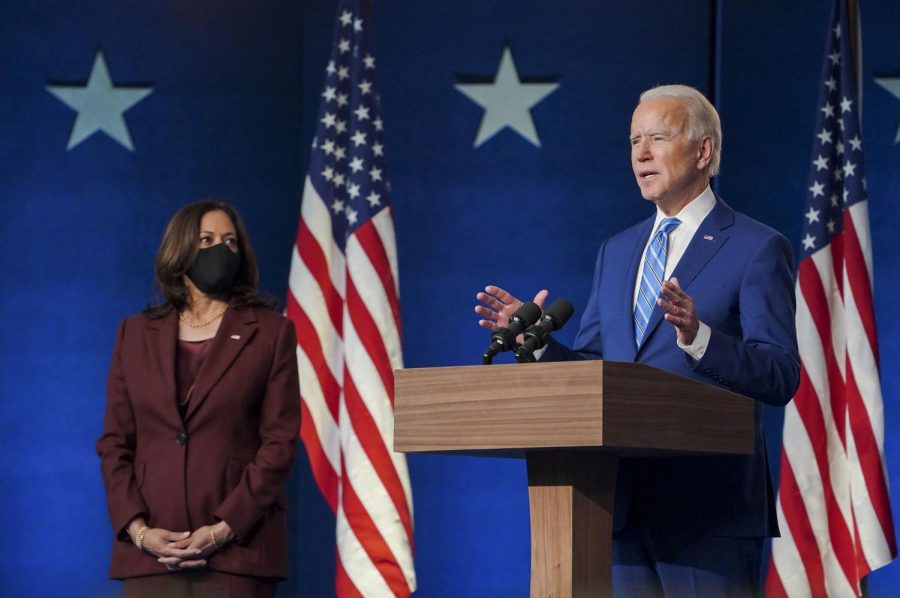Biden Has “Blue Wall” to Thank for Victory
In an election with record-breaking voter turnout and extremely small margins of support between the candidates, Joe Biden pulled in a victory, surpassing the 270 electoral votes needed to secure the presidency with the win of Pennsylvania. Biden flipped a total of three states: Pennsylvania, Michigan and Wisconsin. All three states had voted red in 2016 in support of Donald Trump, although each of them had a history of voting in favor of Democratic candidates in past elections.
The first substantial sign of a victory for Biden came when he won Michigan and Wisconsin, two extremely important states in terms of clinching the presidency. Biden was declared the winner in both of these swing states on Wednesday, provoking Trump’s legal team to respond that the votes should not be considered final. In Michigan, Trump’s team attempted to stop the vote count. Bill Stepien, Trump’s campaign manager, said, “[We have] not been provided with meaningful access to numerous counting locations to observe the opening of ballots and the counting process, as guaranteed by Michigan law.” Here, Stepien is referencing the Michigan law requirement that at least one election inspector from each major political party must be present at the vote counting location.
Nonetheless, the count continued and eventually announced Biden as the winner, though Trump’s team may continue their lawsuit. Michigan was a hefty win for Biden with 16 electoral votes. The state has a primarily Republican history, voting red at its conception up until the Great Depression, and throughout most of the 1970s and ’80s as well. However, Michigan became part of the “Blue Wall,” voting Democrat from 1992 up until 2016, when the state flipped red once more in favor of Trump. Trump won Michigan by a narrow margin in 2016 of only 0.2% . This proved to be the narrowest state win in 2016. However, the state flipped again this year, turning blue in favor of Biden. This could be for a myriad of reasons, one being that Michigan residents who voted for Trump in 2016 came to regret their vote and wanted to vote him out in 2020. Another reason may be that increased voter turnout resulted in more Democratic voters flooding the ballots.
An additional important win for Biden came in Wisconsin, another significant midwestern state with 10 electoral votes. Trump’s team had qualms with this state win as well, with Stepien announcing that the campaign team would move to request a recount in the state. Stepien cited “… reports of irregularities in several Wisconsin counties which raise serious doubts about the validity of the results” as reason to move forward with a lawsuit. Wisconsin law does allow for a recount when the margins between the candidates are especially small, specifically 1%or less. However, unless the margin is less than 0.25%, Trump will have to pay for the recount himself, which will cost an estimated $3 million, provoking the question of just how concerned Trump’s campaign is with alleged voter fraud. In accordance with Wisconsin state law, Trump’s campaign must wait to submit their request for a recount until all 72 of the state’s counties have submitted their full results. The campaign then has a window of opportunity to submit a request until the evening of the following business day.
Wisconsin shares a similar voting history to Michigan, voting red up until the Great Depression and then flipping back and forth, though usually trending Republican. Wisconsin voted blue in 1988, as well as in the six subsequent elections, solidifying Wisconsin as a primarily Democratic state. Trump succeeded in flipping the state back to red in 2016, yet by another narrow margin, this time of 0.7%. Wisconsin was one of Trump’s more shocking wins in 2016, since not a single poll had shown Trump in the lead. Biden flipped the state back to blue in this election, securing the 10 electoral votes and helping to consolidate his lead against Trump.
Perhaps the sweetest victory of all, though, came in Pennsylvania, the state that propelled Biden past the 270 electoral vote mark. A Scranton native himself, Biden was able to claim the state’s 20 electoral votes. Trump’s campaign is juggling multiple lawsuits in Pennsylvania, first attempting to prevent the Supreme Court ruling that granted the state a three-day extension to receive mail-in ballots. Similar to the campaign’s handling of Michigan, Trump’s campaign also attempted to cease the vote count in Pennsylvania, citing the same issues of not enough oversight by Republicans during the counting process. Lastly, Trump’s campaign lost a lawsuit attempting to gain greater observation of ballot counting in Philadelphia.
Pennsylvania, a well-known battleground state, is known to flip back and forth by narrow margins from election to election. However, Pennsylvania is notably the third of the “Blue Wall” states, along with Michigan and Wisconsin. The fact that the three states Biden managed to flip back to blue are the three states making up the “Blue Wall” is notable, provoking ideas that the 2016 election might have been an inconsistency compared to future voting patterns. The “Blue Wall” basically means that Pennsylvania, Michigan and Wisconsin voted blue in every presidential election starting from at least 1992 up until 2016. Trump won Pennsylvania by 0.7% in 2016, and Biden managed to flip his home state back to blue.
Although Biden’s flipped states were by very close margins, nearly all of the states’ voting margins were shockingly narrow. This year’s election was certainly a nail-biter, with plenty of states being called with voting margins of less than 1%. Although Biden might be seen citing the “blue wave” for his win in the near future, in reality, it is the “Blue Wall” he has to thank.
Taylor Herzlich, FCRH ’23, is a journalism major from Mt. Sinai, N.Y.

Taylor Herzlich is a senior at Fordham College at Rose Hill. She is majoring in journalism with a minor in English. Taylor started writing for the Ram...










































































































































































































